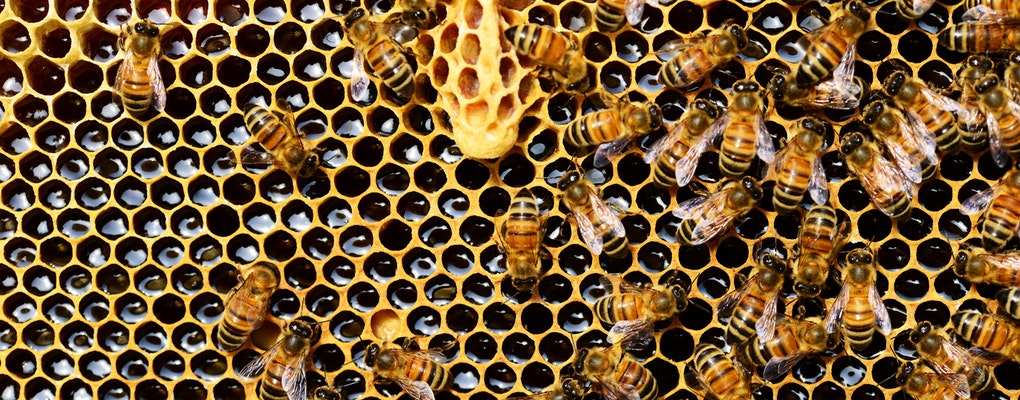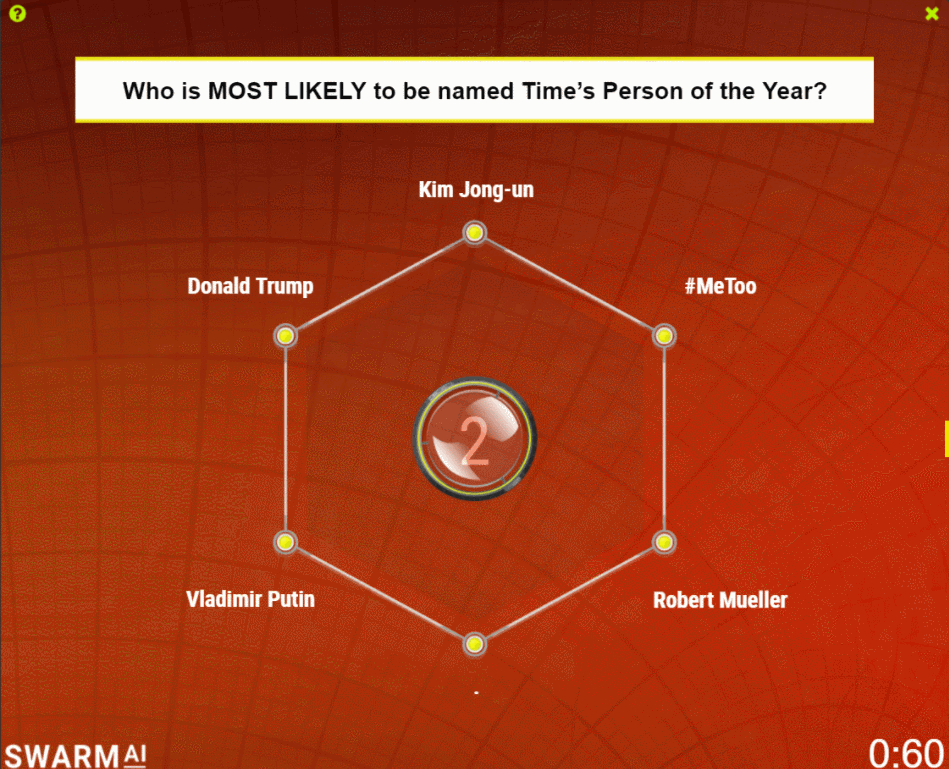What Is Swarm Intelligence?
Swarm Intelligence dictates that groups are smarter in thinking as compared to individuals. It exists when many individuals coordinate with one another in decentralized systems of control based on the principle of self-organization. We often see this manifest in nature such as flocks of birds, a swarm of bees, and school of fishes. Swarm intelligence combines the powers of many into one.
Swarm intelligence is beautiful because it allows the exploration of a variety of alternatives based on a principle of collective wisdom that is often generated based on the environmental surroundings and individual interactions among the members.
Thanks to the advent of AI, we can now implement swarm intelligence to humans. People can collectively work together to make predictions, pick stocks, reach decisions, ask questions and more by applying artificial swarm intelligence.
Swarm intelligence is often studied in two major areas:
Natural Systems: Natural systems comprise of the swarms that manifest in biological systems such as the colonies of termites and ants, a herd of land animals and more.
Artificial Systems: Artificial Systems comprise of systems generated by humans such as robotics and more.
Swarm intelligence is based on the following characteristics:
- The system is composed of a large number of individuals
- The system is composed of homogenous individuals having similar characteristics.
- Information must be exchanged among the individuals either directly or via the environment. In other words, the group must operate on the basis of self-organization.
- Interactions among the individuals must only be based on local information.
Research in the field of Swarm intelligence started back in the 1980s. Since then it has found its application in many practical fields such as optimization problems, social sciences and engineering.
Swarm Intelligence makes a system flexible since swarms modify their behaviour according to their surroundings. Therefore they can adapt to varying landscapes and problems. Moreover, since the system is not dependent on a particular individual in the group, it is robust and continues to perform even if some members of the group become inactive and unable to perform.
Swarm intelligence also makes a system scalable, it can work in small groups to large groups compromising of millions of individuals without affecting the quality of the system or requiring any changes. The system works fast, changes can be incorporated into the system quickly. Swarm intelligence also makes it possible to perform parallel actions in the system because individuals in the system can work by performing different actions simultaneously at different places. This makes the system much more useful as it makes it more flexible and it allows the swarm to work on different complex aspects of the task simultaneously.
On the downside, it is difficult to predict the behaviour in a system based on swarm intelligence. Even if one understands the behaviour of an agent working in the system, it will be difficult to predict the behaviour of the whole swarm or colony. The system is highly sensitive to changes. Even a small change in the environment of the swarm or colony may result in the change in the system.
Humans did not develop swarm intelligence naturally because unlike other creatures they do not have the subtle connections amongst each other to form a tight feedback loop. For instance, birds detect movement in the flock. Fish detect the tremors in the water. For humans, until a few years ago no such connection was possible. However, now due to the revolution in information technology, such connections have become possible. Today we can use the internet and other technology to connect with almost anyone located anywhere in the world. This connection can be used to produce swarm intelligence by converting these connections into systems with closed Feedback loops.
Swarm Intelligence has become an important discipline of artificial intelligence. Swarm AI enables the generation of collective wisdom from human swarms. This collective wisdom is used to solve problems, make predictions, ask questions, and much more. Arguably, Human swarms are known to have amplified the intelligence of the decision significantly.
A study conducted by Unanimous AI and Oxford University showed that Swarm AI was able to predict 50 English premier league games in 5 consecutive weeks. Moreover, it was interesting to note that people who had a predictive accuracy of 55% individually had their predictive accuracy amplified to 72% when predicting together in swarms.
Unanimous AI has developed “Swarm” a cloud-based AI swarm intelligence platform that allows people and networks from all over the world amplify their intelligence by working in decentralized, self-organized groups.
In Another study, it is interesting to note that 30 average sports fans when working together in a closed loop system were collectively able to out-predict the supercomputer SAM in 4 out of 5 weeks during English Premier League season. SAM computer is a supercomputer that is being used by BBC to provide expert level predictions to their audience.
Furthermore, it is interesting to note that by tapping into the principle of swarm intelligence almost 30 members of the swarm were able to amplify their collective predictive intelligence by almost 131% as opposed to their individual predictive intelligence.
Based on the examples cited above, it is evident that swarm intelligence can be used in business forecasting and other areas to generate “artificial experts” that provide intelligent solutions and insights more accurately as compared to traditional methods.
Swarm AI is rapidly becoming popular in the industry. Enswarm is using Swarm AI to assist with recruitment and employment. Swarm.fund is using a combination of cryptocurrency and Swarm AI for fundraising. Unanimous AI is using Swarm AI to create unified intellect in a group of networked individuals. In Fact, Unanimous AI’s Swarm intelligence has predicted Time’s person of the year for the second year in a row.
How Swarm Intelligence Predicted Time’s Person Of the Year Correctly
TIME’s magazine has a legacy of predicting the person of the year since the 90s. It’s a controversial award that is often given to people who have received the most attention in the news. Previously this award had been given to figures like Mahatma Gandhi and Adolf Hitler. In 2017, the nominations for the award consisted of 33 prominent figures from diverse backgrounds such as Elon Musk, Mark Zuckerberg Vladimir Putin and Donald Trump. A powerful social campaign #metoo was also included among the list of contestants.
Choosing between more than 30 individuals each having a diverse circle of influence was no easy task. Unanimous AI tackled this problem by tapping into their Swarm AI platform. An artificial swarm was created by grouping randomly selected individuals from the public. Swarm AI generated insights by amplifying intelligence, wisdom and intuition of the participants in the swarm through a convergence of opinions. These individuals were asked different questions that allowed them to converge on the top five contestants in the list without directly voting for their favourite candidate.
The participants on the swarm platform first narrowed down their list of potential winners by voting out the contestants that are least likely to become featured as TIME person of the year. The screening was done on the basis of convergence of the opinions received from the individuals in the swarm. Later, once the least favourable options had been screened out, The participants in the swarm were asked to predict the top 5 potential winners among the candidates.
On November 30th, the predictions from the swarm were announced. The predictions showed that the top contestant among the list was #metoo campaign closely followed by Donald Trump coming in second. These predictions were proven to be 100% accurate once the results were announced by the TIME magazine. The TIME’s person of the year was the “Silence Breakers”, the people who spoke out against sexual harassment under the umbrella of the #metoo campaign. Trump was voted as the second most influential person on the list.
It is interesting to note that these predictions were not made by experts, all the opinions were taken from randomly selected individuals in the public. This 100% prediction accuracy was achieved due to the amplified intelligence and predictive accuracy of swarm intelligence. The intelligence of average individuals from the public was amplified once it became unified with the intelligence of other members in the group.
Swarm AI is based on the principle of combining human intelligence with computer networking algorithms to produce what Louis Rosenberg, CEO and Founder Unanimous AI, call as a hive mind that is smarter than the individual mind or even regular AI. Swarm AI is a powerful technology and it can be used to truly develop a hive mind that makes predictions about potential problems and initiates precautionary measures to minimize the potential damage. It can generate business intelligence to improve operations, gather customer insights, and Swarm AI can also be used in predicting and preventing many social issues in society.
The success of Swarm AI for two years in a row in correctly predicting the TIMES’s Person of the year is a testament to the effectiveness of this technology.



1 Comment
Thanx for sharing this information i m an electronics engineer student it helped me a lot